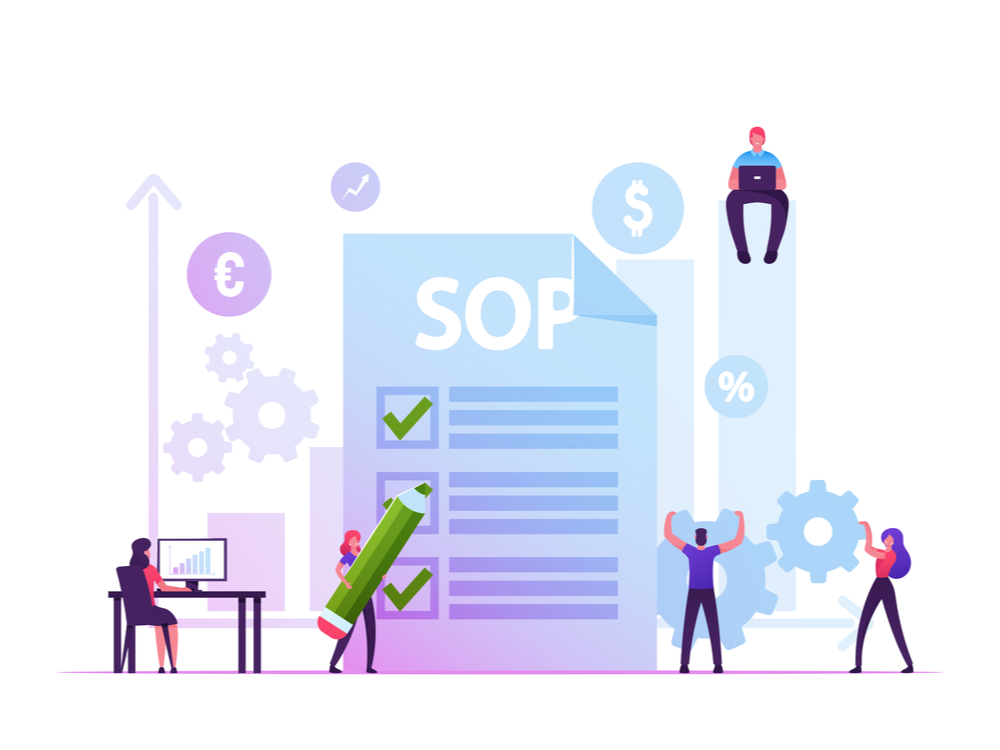Visionary entrepreneurs are accustomed to tackling big challenges and generating substantial results. True, not every idea yields gold. But the alchemical process of testing your ideas and solving problems is a legitimate rush.
On the flipside, there will always be less glamorous aspects of starting and running a business. The details that are tedious and drab to manage. But just as nuts and bolts hold together the most sophisticated and gorgeous sports cars, these basic components of your business will give it structure and enhance its performance.
Perhaps there’s nothing more representative of this “nuts and bolts” principle than standard operating procedures (SOP). Are there any words in our language more boring than “standard,” “operating,” and “procedures?” Yet they combine to create the outlines that consistently get your business from “Point A” to “Point B.”
Standard Operating Procedures (SOP) Meaning
Let’s start with an SOP definition. Standard operating procedures are documents that outline the steps required to complete a process. Rather than a synopsis, you get helpful directions from an SOP, meaning a new employee could study the document and then carry out that specific activity for your business.
Returning to the sports car example referenced above, if you owned a luxury car dealership you might need standard operating procedures for moving the Lamborghini Veneno from one side of the showroom to the other. After all, when an employee is operating a multi-million-dollar machine, you never want to simply say, “Go grab the keys and drive that thing over there in the corner.”
Your standard operating procedure document might be a checklist. In other cases, it could just be a numbered series of steps. The SOP template you use isn’t nearly as important as the clarity you use. Choose the format that makes the process so clear that it’s impossible for it to be misunderstood.
Benefits of Standard Operating Procedures
The fact that you are seeking out resources such as this guide proves that you’re an entrepreneur who cares about quality and improvement. Your thirst for knowledge has propelled you this far in life, and will continue to help you refine your business and deliver even better for your customers.
Standard operating procedures will always take on a higher level of significance for entrepreneurs such as yourself. When quality matters, adherence to process matters.
Of course, you won’t be carving your standard operating procedures into stone. There’s always room for new ideas and better efficiency. You should encourage this type of innovation among your team. But any of those enhancements must be promptly recorded within the SOP document, so that everyone’s on the same page at any given time.
Here are some key benefits that often come with the usage of standard operating procedures:
- Consistent quality
- Employee efficiency
- Increased productivity
- Employee safety
- Faster onboarding of new employees
- More accountability
- Fewer disagreements among employees
- Faster resolutions to problems
- Better customer experience
- Retaining organizational knowledge
Raise your hand if you’d like to bring more of those benefits into your business. Good, then let’s look at how to create these crucial documents.
Choosing Your Standard Operating Procedure Template
Can you imagine how hypocritical it would be for your standard operating procedures documents to go around preaching consistency to your team if they themselves were structured in a bunch of different formats? This is why you need to identify an SOP template that works for your business and then stick to it.
When documentation is handled in a consistent way, your team will benefit from the equity. For example, they’ll know exactly which sections of the document contain specific information and will be able to quickly locate answers if they have questions.
The goal isn’t to choose the same standard operating procedure style that Apple or BMW or Coca-Cola use, but to find an SOP template that aligns with your business so that it feels intuitive. The style that works for you will be as unique as your strategic vision, so it’s important to consider a wide range of options in order to find your winner.
Here are 4 of the most popular standard operating procedure template possibilities to consider:
1. The Checklist: This is one of the clearest ways to break down the elements of a process. And if your document utilizes a to-do list approach that employees check off as they go, it’s easier to confirm completion before progressing to the next stage. For this reason, checklist-style SOP templates are ideal for onboarding new employees and simplifying processes for your existing team.
2. The Step-by-Step List: Another simple way to outline your processes is with a step-by-step format. This standard operating procedure template allows the various steps to provide more robust details to ensure a streamlined and accurate process. Given these explanations, the step-by-step format can work for anyone from new employees to tenured leaders.
3. The Flowchart: The success of your business is often based upon decisions, and this SOP template style illustrates those decisions as an interrelated chain of events. Visual learners in particular will be better able to grasp the prescribed path to the desired outcome. Because of the increased sophistication of this format, it takes more effort to compile a flowchart POS document than would be needed for the checklist or step-by-step formats.
4. The Hierarchical Path: Many business processes involve key steps that each contain a series of smaller actions. Rather than create a mile-long checklist where each task is equally weighted, you can make buckets of subtasks under the major milestones. This hierarchical style is ideal for teams where members have varying degrees of familiarity with the process at hand, as those who know the drill can quickly navigate the main points and new employees can expand the subtasks to learn more.
There are strengths and weaknesses to each SOP template, so your objective is to find the option that maximizes your unique strengths and doesn’t exacerbate your weaknesses.
Compiling Your Standard Operating Procedures Document
After you’ve identified your preferred SOP template, it’s time to craft a document that is anything but standard. Your goal should be brevity, while also delivering information that’s so logical no reader could ever misunderstand. And if you don’t already know, you’ll learn that writing less content is more difficult than writing more.
The French philosopher Blaise Pascal perfectly captured the paradoxical nature of fewer words requiring more effort when he penned: “I would have written a shorter letter, but I did not have the time.”
Be sure to carve out ample time when putting together your standard operating procedures. This will allow you the opportunity to review each task and ensure the most streamlined and accurate descriptions.
Seek Insights from Others
You might know more about a certain business process than anyone on earth. After all, you probably created it in the first place. But that familiarity doesn’t mean you alone should be the architect of the standard operating procedures.
Take a moment to think about the last time you explained something that you knew backward and forward to someone who had little experience with it. Your wealth of knowledge in these situations can actually be a hindrance, as you won’t be able to put yourself in the shoes of someone approaching the topic with a blank slate. You simply won’t be able to anticipate all the elements that will trip up the listener.
For this reason, it’s essential that you talk to your team members who are already carrying out the process. They’ll be able to provide insights into what steps are most important and even alert you of recent developments you might not have been aware of.
You’ll also want to seek the opinions of those who will be carrying out the process in the future. Find out which steps of the standard operating procedure make the most sense and then use those as your best practices for improving the less accessible steps.
One final benefit of seeking the input of others is that it will demonstrate how much you care about your team and respect their contribution. The end result is your people buying into the process and feeling more accountability over how it’s carried out.
Mapping the Journey
You’ve put your initial thoughts on paper. You’ve consulted with your team. Now it’s time to distill this information into a simple journey from “Point A” to “Point B.” To do this you’ll need to identify both the starting point and the expected outcome.
Next, seek out the potential hurdles. Where has the process gone awry in the past? What are the current obstacles that need to be addressed, and ultimately, remedied? You’ll give your SOP document a much longer shelf life if you ensure it provides solutions in addition to facts.
Just as any journey can get waylaid by distractions, your SOP document can suffer the same fate if you don’t keep it dialed in. There will always be more details and interesting anecdotes that could be included in the standard operating procedures than should ever live within it.
You can prevent this issue by drawing lines in the sand before you begin. What will be included and what is superfluous? Once the scope has been agreed upon, which is a discussion for all the stakeholders you involved in the earlier stages, you can rest easy that it won’t spiral out of control.
Putting It All to the Test
Think you have your standard operating procedure ready to roll? There’s only one way to find out. The best way to test the efficiency and efficacy of your SOP template is to release it into the wild of your business.
We recommend a two-pronged approach, as this is an experiment, after all. Have some team members continue using the legacy methods, while another group implements the new standard operating procedure.
If the test reveals problems with the new process, consider yourself lucky. Rather than doing a complete rollout that forces your team to toil under a flawed system, you’ve been alerted that there’s still work to be done. You have the option of either reverting to the old way until the new process is fine tuned, or moving forward with the new standard operating process with the knowledge that it needs improvement.
Defining the Destination
It’s one thing to know where you want to go, but that knowledge is diluted if you don’t know how to confirm you’ve effectively reached it. Your standard operating procedures should be paired with metrics that will allow you to track and grade the performance.
For example, if you’re putting together an SOP document for your manufacturing process, you’d want to consider factors such as:
- What is the average production time?
- What is the desired manufacturing quota?
- Have the preexisting obstacles been solved?
Viewing your processes through this lens makes it possible to identify issues that have still avoided correction, as well as new problems that might have unexpectedly popped up. It also provides the insights you need in order to set meaningful goals.
Your teams handling the processes will appreciate these insights, as they’ve already weighed in on the SOP document and feel ownership. You can commend them for their successes whenever relevant, but also have a common language for tougher conversations when weaknesses are exposed. The good news is that individuals don’t feel personally attacked when you’re working off a collaborative document.
If you’re interested in more business-boosting insights that can improve your processes, check out our library of free training courses. From starting your business to perfecting your sales strategies, these courses are tailored for entrepreneurs who are on a mission to build something meaningful.



















